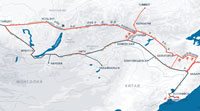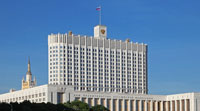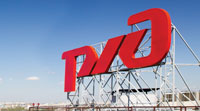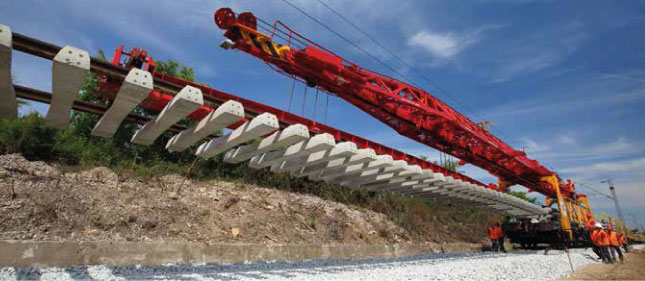Main achievements of Russian Railways
Implementation status of the Russian Railways Group’s Development Strategy until 2030
On 20 December 2013, the Russian Railways Board of Directors approved the Russian Railways Group’s Development Strategy until 2030, which specifies the goals and objectives, key priorities and long-term development projects of the Russian Railways Group.
In order to implement the Russian Railways Group’s Development Strategy until 2030 (hereinafter the Group’s Strategy), an Action Plan has been approved to put the Group’s Strategy into effect.
Based on the decision of the Russian Government, a long-term development programme has been prepared for Russian Railways and its subsidiaries and affiliates (S&A) until 2020 (hereinafter the LDP) as the first stage of the Group’s Strategy, which was approved by the Russian Railways Board of Directors on 1 December 2014
Key results by business units

- Total freight turnover of 2,954.5 bln tkm in 2014, an increase of 5% compared with 2013.
- Handling totalled 1,226.9 mln tonnes in 2014, a decrease of 0.8% compared with 2013.
- The share of shipments delivered in the required (contractual) time was 87.1%, an increase of 9.6 percentage points compared with 2013.
- As a part of the integration of French logistics company GEFCO, construction was completed on a terminal to handle wheeled vehicles at the freight yard of the Doskino station.
- As a part of projects to organise freight train traffic according to the schedule, 14,500 freight trains were shipped in 2014, up 64.8% compared with 2013 (8,800 trains in 2013).
- As a part of the implementation of the ‘Trans-Siberian Mainline in 7 Days’" project, freight was delivered from Primorye to Moscow in December 2014 by container train in less than seven days with route speed of 1,350 km/day.
- As a part of the development of electronic document flow, freight shipments were organised from Russia to Finland with paperless technology using electronic shipping documents.
- Completion of the establishment of intermodal logistics operator UTLC to serve Eurasian space.
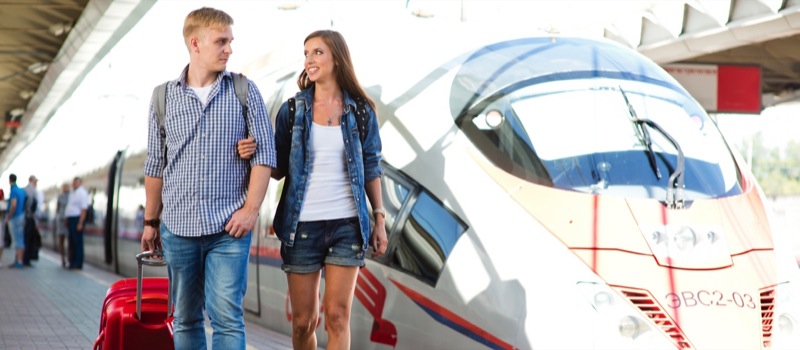
- Passenger turnover totalled 128.8 bln passenger km, down 7.0% compared with 2013.
- A total of 1,070.3 mln passengers were transported in 2014, a decrease of 0.9% compared with 2013.
- The ‘Framework for the development of suburban passenger railway transportation’, which specifies the key principles for organising, regulating and funding the activities of suburban transportation, meets the public’s demand for high-quality suburban transportation and creates conditions for the sustainable development of this railway transportation segment, was approved by Order No. 857-r of the Russian Government dated 19 May 2014.
- Double-decker Sapsan trains began running between Moscow and St Petersburg.
- Lastochka (Desiro RUS) trains were put into operation on the routes: St Petersburg-Bologoye-Veliky Novgorod, Moscow-Nizhny Novgorod, Moscow-Kursk, Moscow-Smolensk, Adler-Krasnodar and Petrozavodsk-St Petersburg.
- Trial runs were conducted of the Talgo train with EP20 electric locomotive along the Moscow-Nizhny Novgorod route.
- Railcar carrier services were established on the St Petersburg-Astrakhan route.
- Lastochka (Desiro RUS) electric trains carried 4.764 mln passengers during the XXII Winter Olympic Games and XI Paralympic Winter Games in Sochi.
- A relevant long-term agreement was concluded for the first time on debt repayment within 10 years as part of the settlement of the Federal Railway Transportation Agency’s debt on payments for public railway infrastructure services for suburban passenger transportation in 2011–2014.
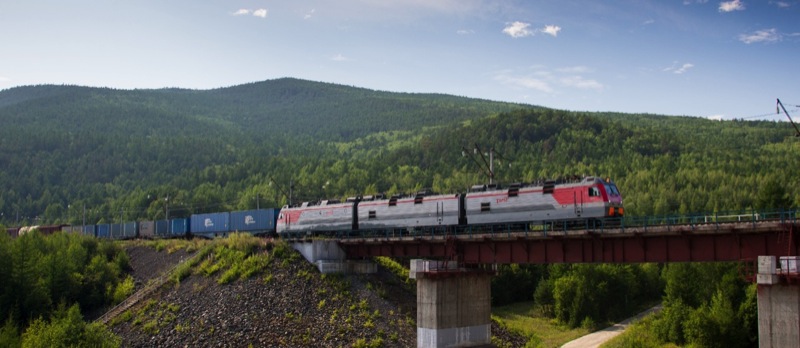
- A major investment project of national importance was launched to modernise the Baikal-Amur and Trans-Siberian Mainlines.
- Certification was completed for the Skif 2ES5 and 2ES7 new generation innovative mainline freight electric locomotives with asynchronous traction motors, and a certificate was obtained for the world’s most powerful electric freight locomotive — the 4ES5K.
- A draft business plan was prepared in accordance with government decisions on the feasibility of developing the Moscow Aviation Hub along with a technology and price audit.
- In accordance with an order from the Russian Government, Russian Railways prepared comprehensive studies on the investment projects ‘Development of railway infrastructure at approaches to ports of northwest Russia’ and ‘Development of railway infrastructure at approaches to ports of the Azov and Black Seas’, including an independent technology and price audit of these investment projects.
- Provisions of the Unified Network Technological Process (UNTP) were introduced, making it possible to achieve positive dynamics in the main rolling stock usage indicators.
- Trains weighing 8,000 and 9,000 tonnes started running regularly on the routes Kuzbass-Northwest ports and Kuzbass-Centre.
In 2014:
- 660 locomotives were purchased;
- a new 4ES5K mainline electric locomotive manufactured by Novocherkassk Electric Locomotive Plant was purchased for the first time to support heavy traffic on AC transmission lines;
- 6,300 km of tracks were rehabilitated, major track repair work was completed in full, 15.6 km of additional mainlines were put into operation and 1,642 running metres of small and medium artificial structures were rebuilt. A total of 978.6 km of railway tracks were rebuilt (modernised) on 128 sections of the Eastern operating domain.
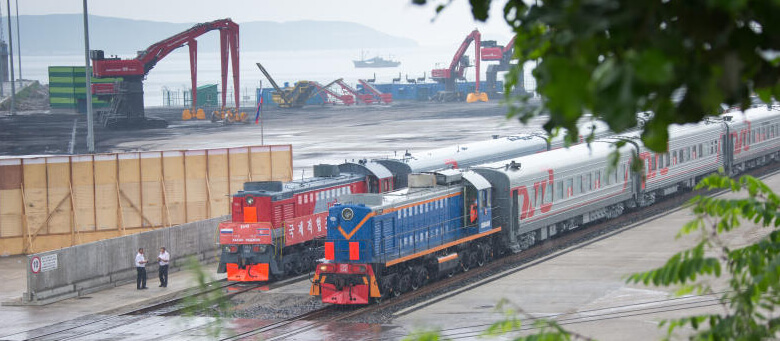
- On 25 March 2014, work began to build and electrify a second railway track from Pancevo Bridge (Belgrade) to the Pancevo Main Station (city of Pancevo) in the Republic of Serbia. Materials and track maintenance equipment were supplied in full to perform construction and installation work. The actual amount of revenue earned by the Russian Railways Group under this contract totalled RUB 1.7 bln in 2014.
- On 18 July 2014, a new transshipment terminal was put into operation at the Rajin port (DPRK) and transit freight shipments were launched through the DPRK with trans-loading at the Rajin port.
- Representatives of Russian Railways along with Vietnam Railways and the Vietnamese company An Vien completed developing the framework for the construction of a railway line in southern Vietnam, which has been submitted to the Vietnamese Government for consideration.
- A study was continued on the Russian Railway Group’s involvement in the implementation of an infrastructure project in Indonesia.
- Studies are under way on the Russian Railway Group’s participation in the comprehensive development of the railway industry in Ecuador as well as construction tenders in Brazil.
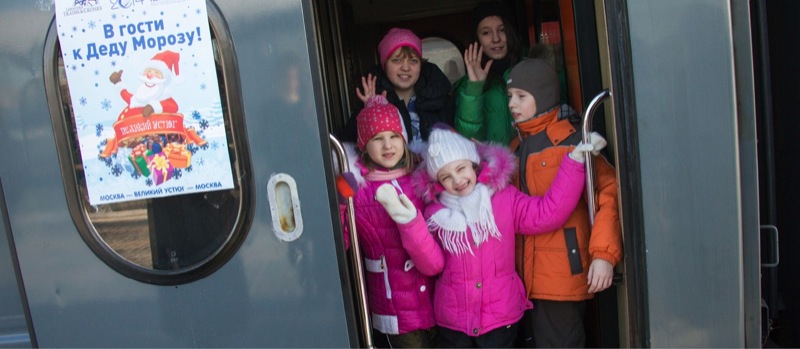
- In 2014, the Company retained its status as a socially responsible employer and maintained social stability in the workforce.
- The Company ensured an economically viable ratio between growth in productivity and an increase in wages. The average monthly salary of Russian Railways employees engaged in all types of activities increased by 5.6% in 2014 to RUB 41,126 (from RUB 38,935 in 2013). Wages were indexed at an average of 3.8% in 2014. Labour productivity in shipment operations grew 10.6%.
- The Company has established a unique continuing education system for all categories and levels of personnel. In 2014, more than 52,000 workers in leading professions underwent training, more than 26,000 people upgraded their skill category, 14,600 people were trained in a second profession and more than 153,000 people upgraded their skills in various courses at training centres and in the workplace.
- In 2014, the following buildings were commissioned following construction: a complex of buildings and structures at the Tynda branch of the Far East Training Centre of Professional Qualifications; a training facility at the Kulunda branch of the West Siberia Training Centre; and a building of the Northwest Corporate Education Centre in St Petersburg.
- Russian Railways fully met its obligations under the collective bargaining agreement in 2014.
- In 2014, the overall injury rate declined 19% compared with the previous year’s level, while fatal injuries decreased 12%
- Occupational safety expenses (measures to improve labour conditions and occupational safety) increased by RUB 300 mln compared with 2013 and totalled RUB 16,604 mln.
- Russian Railways spent RUB 2,543 mln on environmental activities as part of investment projects in 2014. Pollutant emissions from stationary sources decreased by 5,000 tonnes in 2014, while wastewater discharges into surface water bodies fell by 1.3 mln m3.
Investment development
The Company carried out investment activities in 2014 as part of the Investment Programme for 2014–2016, which was approved at a meeting of the Russian Railways Board of Directors on November 2013
One of the main objectives in 2014 as part of the execution of the Russian Railways investment budget was the implementation of projects to fulfil the orders of the Russian President and Russian Government, including:
- the modernisation of the railway infrastructure of the Baikal-Amur and Trans-Siberian Mainlines with the development of traffic and carrying capacity;
- the comprehensive reconstruction of the Mezhdurechensk-Tayshet section;
- the reconstruction of the M. Gorky-Kotelnikovo-Tikhoretskaya-Krymskaya section with a bypass of the Krasnodar Hub;
- the development of the railway infrastructure of the Moscow Transport Hub.
In addition, Russian Railways used budget funds in 2014 to:
- support measures to develop the carrying capacity of railway infrastructure at approaches to ports in Russia’s northwest, south and Far East;
- 660 locomotives were purchased;
- 3,950.8 km of railway tracks were rebuilt;
- measures were taken to ensure the safety of the transportation process.
On 1 December 2014, the Russian Railways Board of Directors approved the Company’s Investment Programme for 2015–2017, which specifies the basic parameters of the Company’s investment activities in 2015.
Results of innovations
In 2014, the Russian Railways Board of Directors approved an updated Innovative Development Programme until 2015 and a report on its implementation in 2013. The programme’s goals are consistent with the Company’s development strategy and involve enhancing the efficiency of operations while continuously improving the quality of services as well as ensuring a high level of transportation innovativeness and safety.
As part of the implementation of the Innovative Development Programme, Russian Railways achieved the following results:
- The energy efficiency of the Company’s core activities increased from 130.5 to 132.8 net tkm/kg of fuel, or by 1.7%, as part of a programme to conserve energy and improve energy efficiency at Russian Railways in 2013–2015
- The Company has introduced and employs a monitoring system for energy conservation measures at all 2,345 of its structural divisions.
- The economic effect from implementing energy conservation and efficiency projects, introducing innovative products and improving technologies totalled RUB 11 bln.
- The Russian Railways Group’s patent portfolio expanded by 9%.
- The manufacturing of the Russian electric locomotive Lastochka (Desiro RUS) series ES2G was set up at Urals Locomotives. During the manufacturing of the first Lastochka train, 62% of production was localised, a level exceeding the contractual requirement of at least 55%. More than 150 Russian companies are cooperating in the manufacturing of the electric locomotives.
- In 2014, Russian Railways fully met the target parameters set by a final resolution of the Management Board for mitigating the Company’s negative environmental impact. Pollutant emissions decreased by 5,000 tonnes, or 6%, in 2014, while wastewater discharges into surface water bodies fell by 1.3 mln m3, or by 10.6%, and the proportion of recirculated production waste increased by 1%. Emissions of greenhouse gases in the CO2 equivalent decreased by more than 1 mln tonnes, or 3%.
- A total of RUB 2,543 mln were invested in environmental projects in 2014.
- The number of structural divisions involved in the Programme of ‘Lean Manufacturing’ Projects increased by 64.3%. Cross-functional projects are being implemented at stations and hubs within railway operating domains in order to improve the operating technologies of related business units. The economic effect from implementing the Programme has totalled RUB 1.04 bln since the start of the year.
- Russian Railways received the Prize of the Russian Government for Quality, which served as an important assessment of the work performed by the Company over several years in two areas: managing the quality of internal processes and interaction with suppliers.
Traffic safety
- The number of accidents and events involving a violation of traffic safety or railway operating requirements continues to decline. In 2014, this figure fell by 31% for the responsibility of the Russian Railways Group compared with 2013 and by 43% at Russian Railways.
- In 2014, the accident rate indicator value, which was set by the Russian Government in the Railway Transportation Development Strategy at 2.0, declined to 1.47 events per mln train-km for the first time. For the Russian Railways Group, the target traffic safety indicator was 2.369 events per 1 mln train-km, or slightly below the target of 2.829 events per 1 mln train-km.
- In 2014, expenses on the implementation of the Traffic Safety Programme totalled RUB 2.8 bln.






